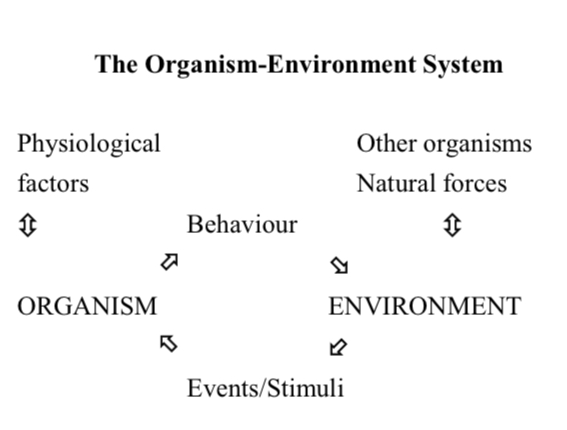L1-L3 Classical Conditioning
1/36
Earn XP
Description and Tags
Flashcards covering key concepts from a lecture on learning, focusing on classical conditioning and related phenomena.
Name | Mastery | Learn | Test | Matching | Spaced |
|---|
No study sessions yet.
37 Terms
Organism-Environment System
Organisms come with unique abilities

Behaviours and Learning
A response to environment and stimuli
Behaviors selected by evolution
Reflexive; hardwired into us eg, blinking
Instinctual; programmed into us eg, imprinting and migrating
Behaviours selected by experience
Learning; A relatively permanent change in behaviour or knowledge as a result of experience. Including habituation, classical conditioning, instrumental conditioning, and observational learning.
Habituation
“Ignoring” stimuli that have become familiar due to repeated exposure. Being startled takes energy. If nervous system deems it safe it adapts to ignore stimuli.
Classical Conditioning Pavlov
Learning by the association of events. Nuetral stimulus is paired with a stimulus that automatically elicits a certain response. The nuetral stimulus becomes a conditioned stimulus that also elicits a similair response.
Neutral Stimulus (NS)
A stimulus that initially elicits no response.
Unconditioned Stimulus (US)
A stimulus that automatically elicits a particular response.
Unconditioned Response (UR)
The automatic response to an unconditioned stimulus.
Conditioned Stimulus (CS)
A previously neutral stimulus that, after repeated pairing with a US, elicits a similar response.
Conditioned Response (CR)
The learned response to a conditioned stimulus.
Conditioned Emotional Responses
Emotions carry distinct physiological correlates such as increased heart rate, muscle tension. Sounds, smells associated with emotional events can elicit emotional responses.
Conditioned Fear
Showed in experiment with ‘Little Albert', who initially had no fear of rats (NS), then they were paired with a bang (US) that made him scared (UR). Then he was scared (CR) when he saw the rat (CS)
Fetishes
Heightened sexual arousal in the presence of certain inanimate objects due to classical conditioning.
UR and CR relationship
Pavlov believed that the CS came to elicit the CR by a process of stimulus substitution; however they found UR and CR are not identical
Compensatory-Reaction Hypothesis
The UR and the CR can be opposites. Eg insulin; The body prepares itself for insulin , and CS produces the opposite response eg blood sugar goes up.
Drug Tolerance
After repeated drug injections, stimuli surrounding drug injections produce a compensatory reaction requiring more of the drug to achieve the same effect.
Drug Overdose
might occur if a drug is administered without the compensatory reaction which requires CSs, because the body is unprepared.
Acquisition
How NS becomes CS. The more intense the US, the stronger the CR, the quicker the rate of conditioning.
CS-US Temporal Relations
The timing of the CS and US can be important in classical conditioning.
Delayed (Forward) Conditioning
CS comes immediately before (and overlaps) with US. Most effective procedure for acquiring CR.
Trace (Forward) Conditioning
The CS starts and finishes before the US. Procedure is less effective than delayed conditioning.
Simultaneous Conditioning
The CS and the US start and end together. Often fails to produce a CR.
Backward Conditioning
The CS begins after the US. The least effective way.
Contingency
The CS must also be a reasonable predictor of the US for conditioning to occur. eg, if you heard the metranome all the time you would stop associating it with meat
Extinction
If the CS is repeatedly presented without the US, then the CR will gradually decrease.
Spontaneous Recovery
After a period with no CS presentations, the CS may elicit the CR again after extinction. Common with anxiety and trauma patients.
Flooding
A behavior therapy application where fear elicited by a CS is eliminated by process of extinction.
Stimulus Generalisation
A conditioned response formed to one conditioned stimulus will occur to other, similar stimuli.
Stimulus Discrimination
An organism does not respond to stimuli that are similar to the stimulus used in training.
Generalisation gradient
Stimuli closer to the CS, produce greater CRs, making an orderly gradient. Not all or none.
Discrimination training
Stimulus A is associated with the US, and Stimulus B is not. If the subject discriminates, the CR occurs only with A. All or none.
Systematic Desensitization
Combines ideas from extinction, stimulus generalization and counter-conditioning. Treatment for phobias and anxiety problems.
Blocking
Conditioning does not occur if a good predictor of the US already exists.
Higher-order Conditioning
Once a stimulus has become an effective CS for a certain CR, then that stimulus can be used to condition other stimuli. A predictor of a predictor.
Sensory preconditioning
Learning occurs in the absence of UR. Classical conditioning reveals the association already learnt between two events.
Taste Aversion Learning
Associations between US & CS are more readily formed if they seem to belong together. Eg aversion to certain alcahol after bad experience.